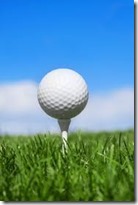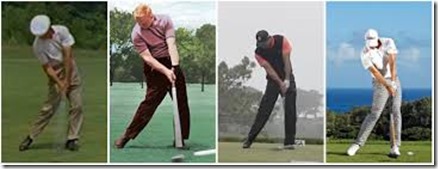Eye on the ball
Have you ever played a sport (involving a ball) where you were instructed to take your eye off the ball?
One time, during my soccer days, I was forced to play goalie – tasked with keeping the goal safe. Having NEVER played this position before, I had little to guide me. I decided to stay with the ‘keep your eye on the ball’ rule that I had religiously applied in other sports (especially tennis). Lo and Behold – I did not let a single goal by. The point of the story is that, there is nothing more powerful (to the brain) than the visual cue of the ball. However, the mind tends to wander – focus on the ball is often compromised – as you tend to notice peripheral objects (other players, audience etc..).
The same applies to golf. In fact, this aspect of the ‘mind wandering’ away from the ball – is especially true in golf. The playing ‘surface’ – so to speak – is the entire fairway all the way – from tee to green – which provides ample visual distractions. In no other sport – is the ratio of the ‘playing surface’ to the target (the small hole on the green) as large as it is in golf.
While Taking your Stance
Your left eye (the LEAD eye for the right handed golfer) is your best friend during the golf setup as well as the swing.
Approach the ball keeping your left eye firmly on the ball (the front or the back of the ball is immaterial – though, I prefer to focus on the back of the ball). Keep this thought in mind – at no time, must your left eye wander away from the ball. Not even when your entire body is executing its turn away from the ball. This is where the heads of most amateurs tend to ‘sway’ a little. Their backswings are so fast that it is not possible to keep a steady head. The head either LIFTS up – or sways to the right. If you stick to keeping your left eye planted on the ball, you will (after a little practice) learn to SLOW down your takeaway – so that you can avoid any sway.
This simple swing thought (keeping your left eye planted on the ball) addresses two very common golf problems
- That of keeping a steady head (under which the body turns)
- That of slowing down your takeaway
Slowing down your takeaway
When you watch pros, you will be surprised at how ‘little’ effort they seem to apply during a full swing. It almost looks like they are yawning – lazily. This is intentional. The slower your backswing – the faster you can make your downswing. This is true because you have a limited amount of energy you can expend on the entire swing (backswing and downswing combined). If you exert most of your energy taking the club back, you will be ‘spent’ by the time you transition into your downswing. More clubhead speed comes from a SLOWER backswing – not a faster one.
From personal experience, this was one of the first things any coach I worked with pointed out. My backswing was waaaay too fast. This would lead to several problems – most noticeably – a loss of balance, a lifting up of the head and the resulting ‘club completely off the swing plane’. So many problems – all rooted in one fault ! Once I practiced slowing down my backswing (using the left eye on the ball trick described above), my downswing improved considerably. Not only was I generating more clubhead speed, I was making center of the clubface contact.
The Professional Downswing
One of the key aspects of a professional downswing is ‘hitting past the chin’. This can only be accomplished if your body executes its swing BELOW a steady head. Note the impact position of Hogan, Nicklaus, Woods and Rory below. They are all hitting past their chins’ UNDER a ‘steady’ head.
Summary
‘Keep you head down’, ‘Keep your head fixed’ .. these are all oft repeated golf instructional maxims. Several coaches, however, warn that this is the WORST golf advice ever. They are partly correct – in that the head must not be RIGID (that leads to a locking up of the shoulders). However, since the head is the AXIS around which the body rotates, it must be kept somewhat STEADY. So – which advice is correct? Head Fixed or not fixed? If steady, HOW steady should the head be? Shouldn’t the CHIN be allowed to swivel ?
Rather than introduce ambiguity (how steady?, how flexible?, how much should the chin swivel?)…it is best to keep your left eye on the ball. This simple focus takes care of all these details (how steady should the head be? Just enough so your left eye does not wander away! Should the chin swivel ? Yes – as much as it wants – provided the left eye stays fixed on the ball).
Try this on a few practice swings – and see if you can manage to keep your left eye on the ball throughout the swing.


Leave a Reply